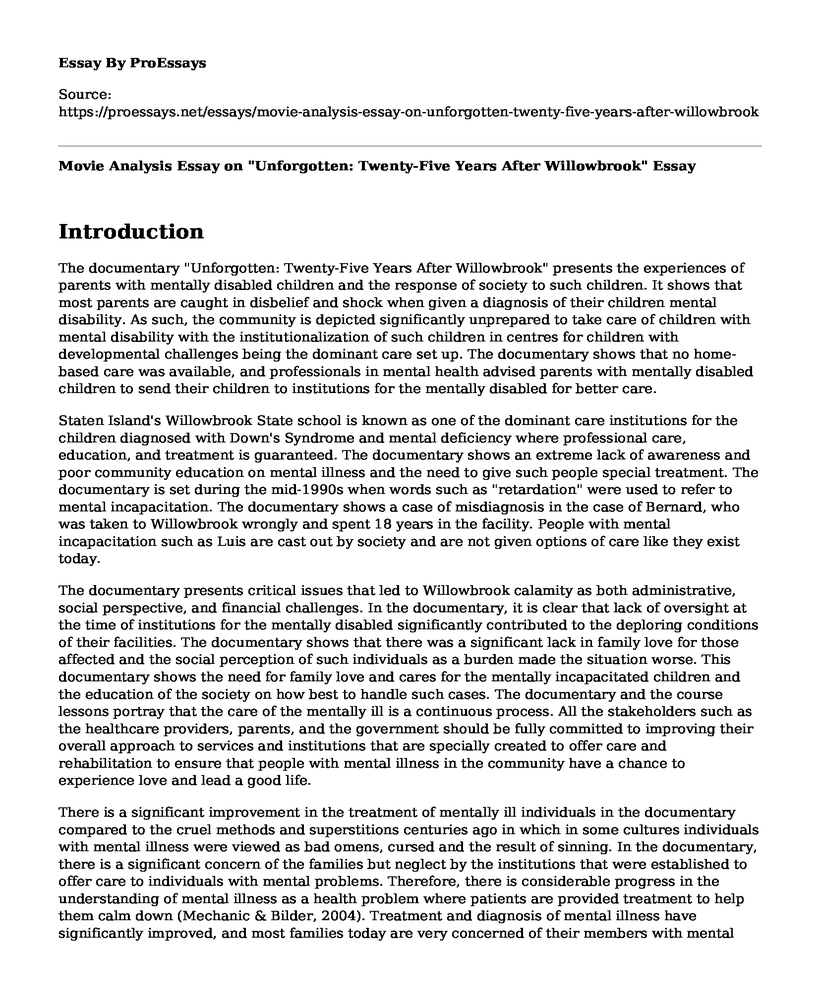Introduction
The documentary "Unforgotten: Twenty-Five Years After Willowbrook" presents the experiences of parents with mentally disabled children and the response of society to such children. It shows that most parents are caught in disbelief and shock when given a diagnosis of their children mental disability. As such, the community is depicted significantly unprepared to take care of children with mental disability with the institutionalization of such children in centres for children with developmental challenges being the dominant care set up. The documentary shows that no home-based care was available, and professionals in mental health advised parents with mentally disabled children to send their children to institutions for the mentally disabled for better care.
Staten Island's Willowbrook State school is known as one of the dominant care institutions for the children diagnosed with Down's Syndrome and mental deficiency where professional care, education, and treatment is guaranteed. The documentary shows an extreme lack of awareness and poor community education on mental illness and the need to give such people special treatment. The documentary is set during the mid-1990s when words such as "retardation" were used to refer to mental incapacitation. The documentary shows a case of misdiagnosis in the case of Bernard, who was taken to Willowbrook wrongly and spent 18 years in the facility. People with mental incapacitation such as Luis are cast out by society and are not given options of care like they exist today.
The documentary presents critical issues that led to Willowbrook calamity as both administrative, social perspective, and financial challenges. In the documentary, it is clear that lack of oversight at the time of institutions for the mentally disabled significantly contributed to the deploring conditions of their facilities. The documentary shows that there was a significant lack in family love for those affected and the social perception of such individuals as a burden made the situation worse. This documentary shows the need for family love and cares for the mentally incapacitated children and the education of the society on how best to handle such cases. The documentary and the course lessons portray that the care of the mentally ill is a continuous process. All the stakeholders such as the healthcare providers, parents, and the government should be fully committed to improving their overall approach to services and institutions that are specially created to offer care and rehabilitation to ensure that people with mental illness in the community have a chance to experience love and lead a good life.
There is a significant improvement in the treatment of mentally ill individuals in the documentary compared to the cruel methods and superstitions centuries ago in which in some cultures individuals with mental illness were viewed as bad omens, cursed and the result of sinning. In the documentary, there is a significant concern of the families but neglect by the institutions that were established to offer care to individuals with mental problems. Therefore, there is considerable progress in the understanding of mental illness as a health problem where patients are provided treatment to help them calm down (Mechanic & Bilder, 2004). Treatment and diagnosis of mental illness have significantly improved, and most families today are very concerned of their members with mental health problems (Mechanic, 2007). The government and non-governmental institutions have invested in facilities and oversight to improve or develop the overall care and prevent the abuse of mentally ill persons today (Parcesepe & Cabassa, 2013). Irrespective of the progress in understanding mental illness, there is still a significant level of stigma in society and the need for further society sensitization.
References
Mechanic, D. (2007). Mental health services then and now. Health Affairs, 26(6), 1548-1550. Retrieved from https://www.healthaffairs.org/doi/full/10.1377/hlthaff.26.6.1548
Mechanic, D., & Bilder, S. (2004). Treatment of people with mental illness: a decade-long perspective. Health Affairs, 23(4), 84-95. Retrieved from https://www.healthaffairs.org/doi/full/10.1377/hlthaff.23.4.84
Parcesepe, A. M., & Cabassa, L. J. (2013). Public stigma of mental illness in the United States: a systematic literature review. Administration and Policy in Mental Health and Mental Health Services Research, 40(5), 384-399. Retrieved from https://www.ncbi.nlm.nih.gov/pmc/articles/PMC3835659/
Cite this page
Movie Analysis Essay on "Unforgotten: Twenty-Five Years After Willowbrook". (2023, Jan 16). Retrieved from https://proessays.net/essays/movie-analysis-essay-on-unforgotten-twenty-five-years-after-willowbrook
If you are the original author of this essay and no longer wish to have it published on the ProEssays website, please click below to request its removal:
- American Sniper: Movie Review
- Interview Example on the Influence of Social Media on Societal Values
- The Devil in a Blue Dress - Film Analysis Essay
- Film Analysis Essay on Deepwater Horizon
- Anxiety and Social Media Essay Example
- Facebook-Cambridge Analytica: The Data Scandal That Shook the World - Essay Sample
- Goya: A Spanish Painter of Romanticism & Court Painter - Biography Sample







